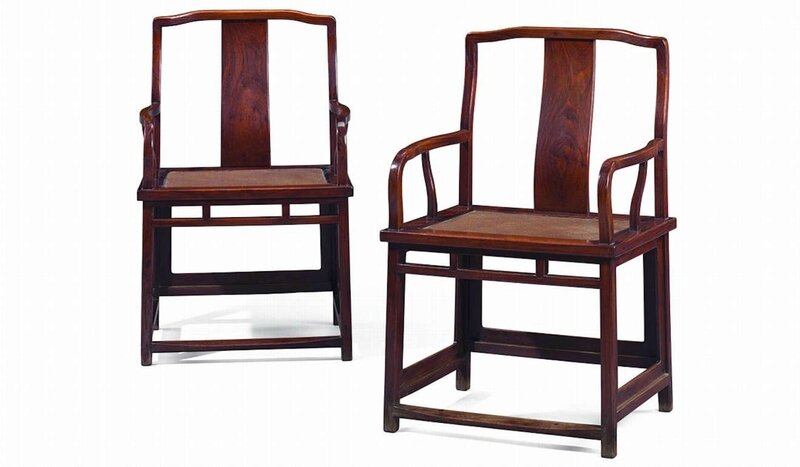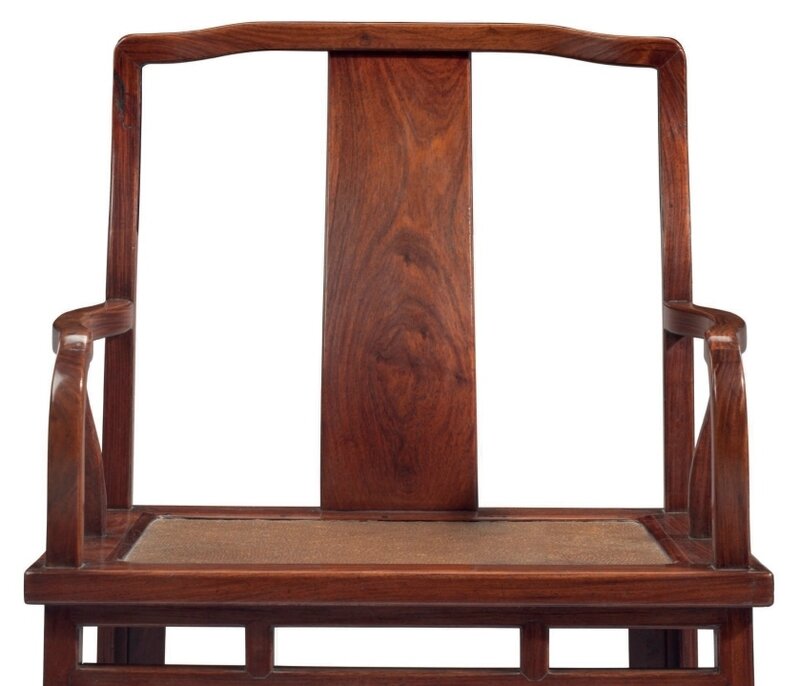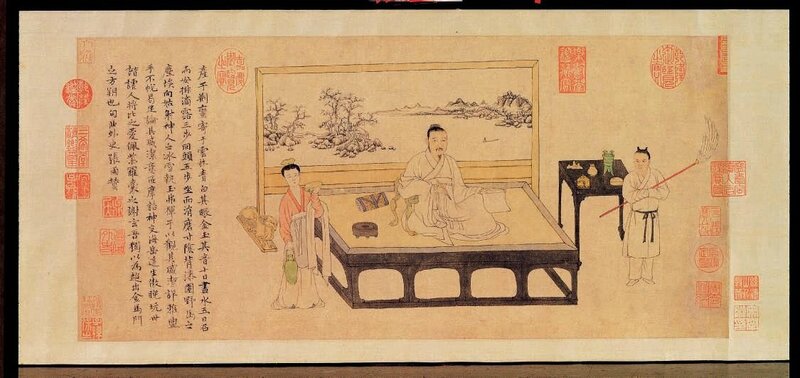The Ecke Chairs. A very rare pair of huanghuali “Southern official’s hat” chairs, nanguanmaoyi, 17th-century
Lot 625. The Ecke Chairs. A very rare pair of huanghuali “Southern official’s hat” chairs, nanguanmaoyi, 17th-century; 39 in. (99.1 cm.) high, 24 7/8 in. (63 cm.) wide, 21 ½ in. (54.6 cm.) deep. Estimate USD 600,000 - USD 800,000. Price realised USD 1,327,500. © Christie's Images Ltd 2017.
Each is constructed from convex square members. The stepped crestrail is supported by a S-shaped splat and curved back posts which continue to form the rear legs. The curved arms are supported on tapering braces and the front posts which continue through the seat to form the front legs. All are above a mat seat set within a rectangular frame above plain aprons fitted with vertical struts in front and plain aprons and spandrels at the sides and back. The legs are joined by plain stretchers at the sides and a foot rest at the front.
Provenance: The Gustav Ecke (1896-1971) Collection, Honolulu.
Robert Moore, Los Angeles.
The Marie Theresa L. Virata (1923-2015) Collection.
Literature: Gustav Ecke, Chinese Domestic Furniture, 1944, p. 104, pl. 82.
As published by Gustav Ecke. Alternate view of lot 626.
Note: Chinese chairs fall into three distinct categories: armchair (guanmaoyi), horseshoe-back armchairs (quanyi), and rose-chairs (meiguiyi). Within these three categories, there exist several sub-sections, such as continuous armchairs, also called “Southern Official’s Hat” armchairs (nanguanmaoyi) and continuous horseshoe-back armchairs. However, newly published furniture references, notably the recently completed multi-volume work by the Palace Museum, Beijing, suggest an unlimited variation of forms within these three basic categories. The 'Ecke' chairs are an example of a variation of the standard armchair.
The 'Ecke' chairs are constructed entirely of square section members. The only decorative relief from this rigor is the incised line to each edge of each square member, which has been gently worn at the front and sides of the seat frame, the arms, and the foot rest. The closest example to the present pair is a chair published by Zhang Jinhua in The Classical Chinese Furniture of Weiyang, Literati Culture and Craftmanship in the Yangzhou Region During the Ming and Qing Dynasties, 2016, pp. 82-85 (fig. 1), which is of comparable form and displays a similar and unconventional arrangement of the front apron. As noted by the author, the common arrangement has the vertical strut set above a humpback or straight lower stretcher, and directly tenons into the underside of the seat frame, rather than the design shown in the illustrated example, which shows a single panel with an upper and lower horizontal member and vertical struts. Zhang argues that this design is an identifying characteristic of Weiyang furniture.
Fig. 1. A zhazhemu ‘southern oficial’s hat’ armchair. Photo courtesy of Zhang Jinhua
The very unusual, and perhaps unique, arrangement of platform-style plain aprons and spandrels on the sides and back of the chair is another strong indicator that the “Ecke chairs” would have originated from an area east of Yangzhou. This design, a derivation of the platform bed construction with a scalloped edge opening (fig. 2), is one of the earliest forms found in Classical Chinese furniture, first seen in paintings as early as the 4th century. This form of construction, seen on the 'Ecke' chairs is typical of Weiyang Ming-style furniture. See, also, a jichimu and nanmu platform, dating to the 17th century, similarly constructed in this box-form style, sold Christie's New York, Important Chinese Furniture Formerly the Museum of Classical Chinese Furniture Collection, 19 September 1996, lot 13 (fig. 3).In his discussion of platform beds, Zhang states that “the frequency with which platform-style furniture appears in early Chinese paintings not only suggests that they were a symbol of elite social status, but also reflects a standard of taste”.
Fig. 2 Yuan dynasty. Portrait of Ni Zan. Colophon by Zhang Yu © The Collection of National Palace Museum
Fig. 3. A jichimu and nanmu platform, 17th century
Christie's. The Marie Theresa L. Virata Collection of Asian Art: A Family Legacy, 16 March 2017, New York, Rockefeller Center

/https%3A%2F%2Fprofilepics.canalblog.com%2Fprofilepics%2F1%2F0%2F100183.jpg)
/https%3A%2F%2Fstorage.canalblog.com%2F03%2F02%2F119589%2F96711876_o.jpg)
/https%3A%2F%2Fstorage.canalblog.com%2F11%2F31%2F119589%2F94773502_o.jpg)
/https%3A%2F%2Fstorage.canalblog.com%2F20%2F83%2F119589%2F94772815_o.jpg)
/https%3A%2F%2Fstorage.canalblog.com%2F26%2F72%2F119589%2F75604929_o.jpg)
/https%3A%2F%2Fstorage.canalblog.com%2F59%2F60%2F119589%2F26458628_o.jpg)











/image%2F1371349%2F20240409%2Fob_fc01a6_2024-nyr-22642-0899-000-a-rare-small-h.jpg)
/image%2F1371349%2F20240409%2Fob_1299ed_2024-nyr-22642-0898-000-a-rare-huanghu.jpg)
/image%2F1371349%2F20240403%2Fob_b08891_telechargement-4.jpg)
/image%2F1371349%2F20240403%2Fob_b24488_telechargement.jpg)